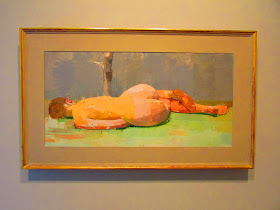Euan Uglow - Curled Nude on a Stool, 1982-83
Another gem of an exhibition staged at Hazlitt Holland Hibbert in St James's. On this occasion a posthumous retrospective of keenly observed figure studies, still lives and drawings by Euan Uglow (1932-2000). At the age of 29 Euan Uglow staged his first solo exhibition as an artist in 1961 at the Beaux arts Gallery, and The Times wrote: "The cool, blond tonality of Mr. Uglow's paintings, his concern for space and volume, and above all the judgement which makes of each portrait, still-life, or nude a sum of precise calculations, carry a very real distinction of their own." Uglow was a student of William Coldstream (1908-1987), and adapted Coldstream's rigorous working methods of measurement. Working strictly to a grid system in the studio Uglow used plumb lines and sighting strings as spatial reference points for both his paintings and drawings. You can still see the presence of the grids in his finished artworks. The act of drawing is, or at least should be, a vital part of every artists practice. The discipline of looking, and then looking again before committing to the process of putting pencil to paper and mark-making ought to be central. “Drawing is the most immediate way of making your ideas, sensations, and information explicit”, the artist has been quoted as saying. Uglow's drawing is both exhaustive and exacting. It must have been quite an ordeal for his sitters to endure given some of the poses the artist put his models through. The results were well worth the effort though, as this exhibition confirms. When juxtaposed against certain props the bodies become almost architectural in form. These figurative parts of Uglow's oeuvre make sense of the phrase 'the architecture of anatomy'. I particularly like the painting Nuria in which the model lies prone, slumped dramatically over a stool, humorously emphasising the shape of the furniture. A distinctive feature of Uglow's work are the tick marks he uses to demarcate the surface and define the forms of the figures and objects in his paintings. It is interesting that he chose to retain these marks along with traces of the drawn grids in the finished paintings as part of his signature style. Composition is a strong point with Uglow. The elements in the paintings here are so beautifully organised as a result of his looking so closely at his subjects and then solving the problems of their arrangement, whether they be intimate, little still lives or his larger figurative paintings. There is usually an element of tension created, especially in the smaller still lives by placing say a plant off-centre, or including an odd corner of a surface plane, or band or block of contrasting colour which serves as a device to lift or enliven the composition. Another aspect of Uglow's art which I think is often overlooked is just how good a colourist he actually is. The colours usually work in close tonal harmonies, or juxtapose vivid primary colours that shine like jewels against the more neutral flesh tones of the figures. Although Uglow painted in flat colour planes, they perfectly describe the play of light on the forms in the paintings in a precise, geometric way giving a solid, sculptural effect to the objects. The colours give a sense of animation and relief to the studied seriousness of Uglow's drawing technique. This was a really well curated retrospective which serves to illustrate why Uglow deserves to be held in as much esteem as his contemporaries such as Lucian Freud and Francis Bacon.
The Blue Towel, 1982
Marigold, 1969
Articulation, 1993-5
Zoe, 1987-93
Yellow Dress, 1993-8
Still Life, 1969
The Diagonal, 1971-77
Polygons, c.1970
Nectarine, 1998
Still Life with Honeysuckle, 1968
Mosque at Ciftlik Koyou, 1966
Evening Light at Yesilirmak, 1985
Skull, 1994-7
Root Five Nude, 1974-75
Shrunken Tangerine, 1988
Is it a Tart, or is it Ayers Rock?, 1998
Curled Nude on a Stool, 1982-83
Propeller, 1994-95
Stop-Start-Stop, 1991
Nuria, 1998-2000
Narcissus on Yellow Background, 1978
Passionate Proportion, 1964
Obelisk, c. 1970
Euan Uglow
until 19th July
Hazlitt Holland Hibbert
38 Bury Street
St James's
London
SW1Y














































No comments:
Post a Comment